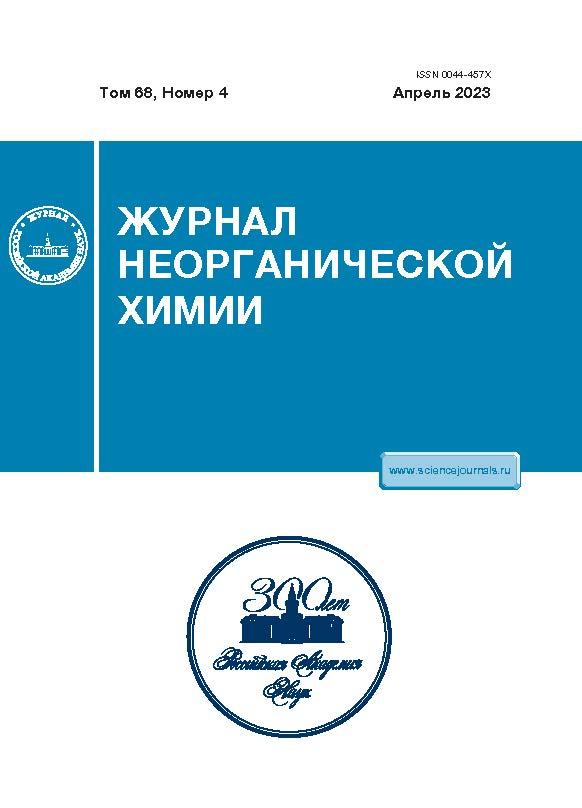A New Structural Type of Bismuth(III) Dithiocarbamato-Chlorido Complexes: Preparation, Structural Organization, and Thermal Behavior of Binuclear Compounds [Bi2{S2CN(CH2)6}4(μ2-Cl)2] and [Bi2{S2CN(CH2)6}4(μ2-Cl)2]·2CH2Cl2
- 作者: Novikova E.V.1, Isakovskaya K.L.2,3, Ivanov A.V.1
-
隶属关系:
- Institute of Geology and Nature Management, Far Eastern Branch, Russian Academy of Sciences
- Nesmeyanov Institute of Organoelement Compounds, Russian Academy of Sciences
- Mendeleev University of Chemical Technology of Russia
- 期: 卷 68, 编号 4 (2023)
- 页面: 471-481
- 栏目: КООРДИНАЦИОННЫЕ СОЕДИНЕНИЯ
- URL: https://kazanmedjournal.ru/0044-457X/article/view/665269
- DOI: https://doi.org/10.31857/S0044457X22601882
- EDN: https://elibrary.ru/FLTIUR
- ID: 665269
如何引用文章
详细
Heteroleptic compounds of bismuth(III) adopting a new binuclear structural type: hexamethylenedithiocarbamato(HmDtc)-chloride of [Bi2(S2CNHm)4(μ2-Cl)2] (I) and its solvated form [Bi2(S2CNHm)4(μ2-Cl)2]·2CH2Cl2 (II) have been isolated and studied by X-ray diffraction, IR spectroscopy, and simultaneous thermal analysis. Despite the identical chemical composition, the structure of binuclear molecules in I and II differs significantly. In the first case, the noncentrosymmetric molecule includes two nonequivalent moieties of [Bi(S2CNHm)2Cl], which are combined by μ2-Cl ligands to form the [Bi–(μ2-Cl)2–Bi] metallocycle in the butterfly conformation: Bi(1)–Bi(2) 4.0785(5) Å, Cl(1)–Cl(2) 3.936(2) Å. On the contrary, in the solvated form II, the complex is centrosymmetric and four-membered [Bi2Cl2] ring is stabilized in a rhombic configuration: Bi(1)–Bi(1)a 3.9592(9) Å and Cl(1)–Cl(1)a 4.540(4) Å. According to the microprobe method, the main residual substance after the thermolysis of the complexes is microcrystalline Bi2S3 with inclusions of metallic bismuth particles.
作者简介
E. Novikova
Institute of Geology and Nature Management, Far Eastern Branch, Russian Academy of Sciences
Email: alexander.v.ivanov@chemist.com
675000, Blagoveshchensk, Russia
K. Isakovskaya
Nesmeyanov Institute of Organoelement Compounds, Russian Academy of Sciences; Mendeleev University of Chemical Technology of Russia
Email: alexander.v.ivanov@chemist.com
119991, Moscow, Russia; 125047, Moscow, Russia
A. Ivanov
Institute of Geology and Nature Management, Far Eastern Branch, Russian Academy of Sciences
编辑信件的主要联系方式.
Email: alexander.v.ivanov@chemist.com
675000, Blagoveshchensk, Russia
参考
- Koh Y.W., Lai C.S., Du A.Y. et al. // Chem. Mater. 2003. V. 15. № 24. P. 4544. https://doi.org/10.1021/cm021813k
- Ozturk I.I., Banti C.N., Kourkoumelis N. et al. // Polyhedron. 2014. V. 67. P. 89. https://doi.org/10.1016/j.poly.2013.08.052
- Jamaluddin N.A., Baba I., Halim S.N.A., Tiekink E.R.T. // Z. Kristallogr. NCS. 2015. V. 230. № 3. P. 239. https://doi.org/10.1515/ncrs-2015-0008
- Новикова Е.В., Иванов А.В., Егорова И.В. и др. // Коорд. химия. 2019. Т. 45. № 10. С. 599.
- Teske C.L., Terraschke H., Mangelsen S., Bensch W. // Z. Naturforsch. 2022. V. 77. № 4–5. P. 203. https://doi.org/10.1515/znb-2021-0176
- Новикова Е.В., Исаковская К.Л., Анцуткин О.Н., Иванов А.В. // Коорд. химия. 2021. Т. 47. № 1. С. 48.
- Bharadwaj P.K., Lee A.M., Skelton B.W. et al. // Aust. J. Chem. 1994. V. 47. № 2. P. 405. https://doi.org/10.1071/CH9940405
- Raston C.L., Rawbottom G.L., White A.H. // Dalton Trans. 1981. № 6. P. 1379. https://doi.org/10.1039/DT9810001379
- Новикова Е.В., Заева А.С., Денисов Г.Л. и др. // Журн. неорган. химии. 2022. Т. 67. № 1. С. 103.
- Иванов А.В., Конзелко А.А., Герасименко А.В. и др. // Журн. неорган. химии. 2005. Т. 50. № 11. С. 1827.
- Бырько В.М. Дитиокарбаматы. М.: Наука, 1984. 341 с.
- Sheldrick G.M. // Acta Crystallogr., Sect. A. 2015. V. 71. № 1. P. 3. https://doi.org/10.1107/S2053273314026370
- Dolomanov O.V., Bourhis L.J., Gildea R.J. et al. // J. Appl. Crystallogr. 2009. V. 42. № 2. P. 339. https://doi.org/10.1107/S0021889808042726
- Yin H.D., Li F., Wang D. // J. Coord. Chem. 2007. V. 60. № 11. P. 1133. https://doi.org/10.1080/00958970601008846
- Казицына Л.A., Куплетская Н.Б. Применение УФ-, ИК-, ЯМР- и масс-спектроскопии в органической химии. М.: Изд-во Моск. ун-та, 1979. 240 с.
- Корнеева Е.В., Новикова Е.В., Лосева О.В. и др. // Коорд. химия. 2021. Т. 47. № 11. С. 707.
- Иванов А.В., Ивахненко Е.В., Герасименко А.В., Форшлинг В. // Журн. неорган. химии. 2003. Т. 48. № 1. С. 52.
- Гремлих Г.У. Язык спектров. Введение в интерпретацию спектров органических соединений. М.: ООО “Брукер Оптик”, 2002. 93 с.
- Тарасевич Б.Н. Основы ИК спектроскопии с преобразованием Фурье. Подготовка проб в ИК спектроскопии. M.: МГУ, 2012. 22 с.
- Bocian D.F., Pickett H.M., Rounds T.C., Strauss H.L. // J. Am. Chem. Soc. 1975. V. 97. № 4. P. 687. https://doi.org/10.1134/S0036023622010077
- Boessenkool I.K., Boeyens J.C.A. // J. Cryst. Mol. Struct. 1980. V. 10. № 1–2. P. 11. https://doi.org/10.1007/BF01209549
- Entrena A., Campos J., Gomez J.A. et al. // J. Org. Chem. 1997. V. 62. № 2. P. 337. https://doi.org/10.1021/jo951950j
- Arda M., Ozturk I.I., Banti C.N. et al. // RSC Adv. 2016. V. 6. P. 29026. https://doi.org/10.1039/C6RA01181K
- Abrahams B.F., Hoskins B.F., Winter G. // Acta Crystallogr. C. 1990. V. 46. № 3. P. 391. https://doi.org/10.1107/S0108270189007420
- Mensforth E.J., Hill M.R., Batten S.R. // Inorg. Chim. Acta. 2013. V. 403. P. 9. https://doi.org/10.1016/j.ica.2013.02.019
- Бацанов С.С. // Неорган. материалы. 2001. Т. 37. № 9. С. 1031.
- Hu S.-Z., Zhou Z.-H., Robertson B.E. // Z. Kristallogr. 2009. V. 224. № 8. P. 375. https://doi.org/10.1524/zkri.2009.1158
- Alvarez S. // Dalton Trans. 2013. V. 42. № 24. P. 8617. https://doi.org/10.1039/C3DT50599E
- Ge Z.-H., Qin P., He D. et al. // ACS Appl. Mater. Interfaces 2017. V. 9. № 5. P. 4828. https://doi.org/10.1021/acsami.6b14803
补充文件
















